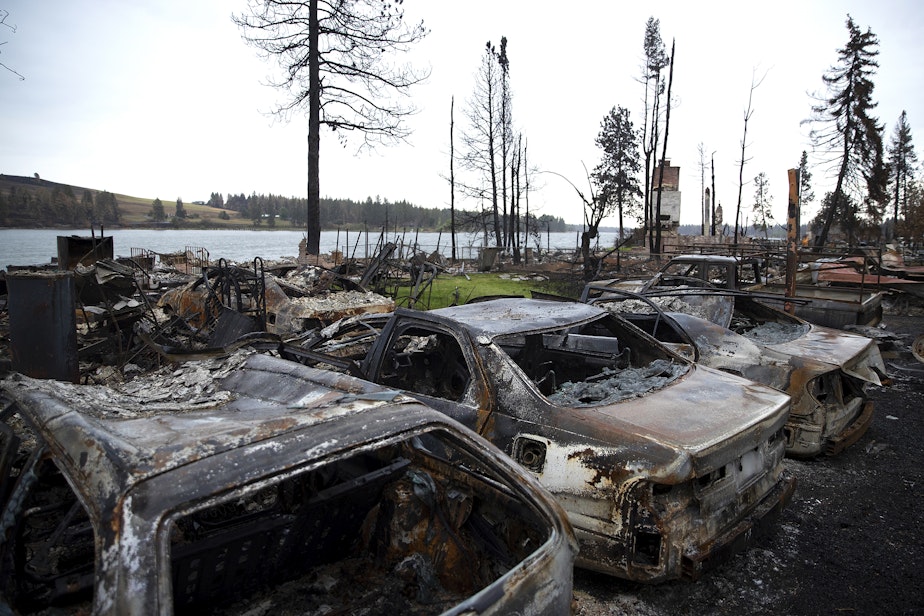Investigation finds utility's security light at fault for devastating Gray Fire

In a new report, the Washington Department of Natural Resources says the initial sparks that started the Gray Fire near Spokane last summer came from a security light mounted on an Inland Power and Light pole. Those sparks ignited nearby brush and the fire quickly raged out of control.
The Gray Fire burned 10,000 acres, forced thousands to evacuate, and destroyed hundreds of homes.
In August, powerful winds and dry conditions led the Gray Fire to spread through the Medical Lake area just outside Spokane. Until recently, the cause of the fire was unknown, but a report from the Washington Department of Natural Resources found that sparks from a nearby security light were the culprit.
According to the report, several locals spotted the fire as it began in the afternoon of Aug. 18. The pole itself was located on a gravel driveway near the Jensen Memorial Youth Ranch and was spotted by several passersby on their way to the ranch, including owner Carl Grub, who died after crashing his truck while driving to Medical Lake. Grub is the only death related to the fire.
Shortly after the fire was spotted, a DNR investigator arrived on scene, and a resident noted the pole had been a problem before the day of the fire.
"So, typical farm has a lot of outbuildings, a house, and a circle drive," said Emma Epperly, a reporter covering the fire for The Spokesman Review. "And so it's in this area in the center of the circle drive. And the president of that property had called Inland Power a couple of times, mentioning that the light had been flickering, but no one came out to look at it is what she told investigators."
After calling to report the sparking, Inland Power arrived on scene and disconnected power from the pole. Three components — an aluminum conductor and pieces of insulation — were photographed by investigators before being removed from the site for analysis at an Inland Power lab in California. Since then, the aluminum conductor has gone missing.
Sponsored
The report comes as civil litigation from wildfire victims against Inland Power is ongoing. The conclusion by the DNR also opens the door for the Washington attorney general to pursue litigation against Inland Power to recover firefighting costs. Gov. Jay Inslee estimated the cost of recovery to be more than $5 billion.
"A lot of these processes are just getting put in place, and people are kind of just starting to get some of that help," Epperly said. "Progress is slow. A lot of people aren't back on their properties yet, some people are living in RVs, others started construction. So progress is really staggered in the area."
Details of the fire feel familiar to those in the Spokane area. The 2020 Babb Road Fire destroyed 85% of the small towns of Malden and Pine City, whose residents are still in litigation against Avista Utilities after a DNR investigation found the fire started from a power line hitting and igniting a tree branch.
The increased risk of red-flag weather conditions and risk of electrical infrastructure has been a focus of state legislators in the last year. House Bill 1032 went into effect in July, requiring utilities in the state to create wildfire mitigation plans. Coupled with millions in federal grant funding, Washington utilities affected by wildfire are looking at what they can do to limit the potential — and severity — of wildfire risk.
The state of California is further along in litigation against utility companies to better prevent fires, and electricity companies are spending big to overhaul thousands of miles of wires and equipment. That includes undergrounding electric lines, coating lines to make them less conductive, and rolling blackouts that limit electrical transfer during high-danger weather events.
Sponsored
In California, those costs of wildfire prevention frequently pass on to ratepayers.
"This really impacts rates," said Joseph Mitchell, a wildfire safety consultant and owner at M-bar Technologies and Consulting. "At some point, you need to start doing the balancing between cost and benefit, between the risk from the wildfires and the risk you're imposing on your lowest-income customers who have trouble paying their electric bills."
Listen to the full Soundside interview by clicking "play" on the audio icon at the top of this story.





